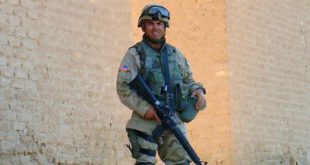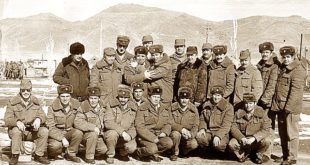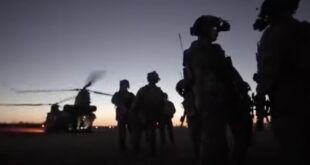COMMUNIST VIETNAMESE SPECIAL OPERATIONS FORCES DURING THE VIETNAM WAR AND THE LESSONS THAT CAN BE APPLIED TO CURRENT AND FUTURE U.S. MILITARY OPERATIONS
by
James M. Cloninger Jr.
This thesis examines the role of communist special operations forces during the Vietnam War and the relevancy of the lessons learned from these units. The United States military, specifically Army Special Forces, Rangers, and Navy SEALS, were not the only forces capable of conducting successful special operations during the conflict. The People’s Army of Vietnam also had a highly organized, well trained, and well equipped organization capable of carrying out special operations. This organization was the sapper arm, and it was composed of three separate types of units. The Urban Sapper was concerned with intelligence gathering, terrorism, assassination, and special operations in the large urban areas such as Saigon and Hue. The Naval Sapper was responsible for attacking shipping, bridges, and bases located near waterways. The Field Sapper conducted operations against deployed US and South Vietnamese troops, trained other communist troops as sappers, and gave the communist leadership an elite force for lightning raids. The sapper force had certain operational principles, organizational constructs, and functional methods that set it apart from any other communist military element used during the Vietnam War.
BACKGROUND
I. INTRODUCTION
During the Vietnam War, communist forces were able to operate in both the conventional and guerrilla spheres. That is to say, the communist military forces were able to conduct force-on-force operations as well as use classic insurgent tactics against US and Allied military forces. These conventional and guerrilla operations could be simultaneous, independent, or supportive of each other. Operating in between the conventional and guerrilla realm was a separate force that acted as both a conventional and guerrilla force. This force was as well trained, well equipped, and highly motivated. Most personal memoirs and histories of the Vietnam War mention this force, often referred to as the “dreaded” Sapper, but little is known or understood today about the Sapper.
The US military historically has had few opportunities to deal with actual enemy special operations forces during combat operations. Enemy special operations or special operations forces often have been cited as a clear danger to US military operations, but rarely has their successes been discussed. This threat was especially true when talking of the Soviet Union and North Korea. However, according to US military history and doctrine, the US has not had to face enemy special operations on a large scale since the end of World War II. Unfortunately, this statement ignores the US military experience in Vietnam. Vietnam should have been a great example of how the enemy could conduct special operations and what the effects on the battlefield could be. Regrettably, American pride has ignored this fact. It seems very ironic that the most well know communist special operation against the US forces, the attack on the American embassy during the Tet Offensive of 1968, has been nearly ignored for what it was.
Much has been written about Tet and the attack on the US embassy in Saigon in 1968, but not about the communist forces that were directly involved in the attack on the embassy. Although the attacking force has been called everything from terrorists to commandos, exactly who these forces were and why they attacked the embassy are questions that seem to have never been addressed. The initial research for this thesis indicated that the attackers were members of the C-10 Sapper Battalion. In turn, the initial definition of a sapper dealt with combat engineers. Yet it did not make sense that a combat engineer would be involved in an attack such as that on the US embassy, and the information on hand did not give a satisfactory answer about who this force was. After more research, though, a pattern developed regarding the war in Vietnam. The communists had certain specialized forces that carried out unique missions. These missions were similar to US Special Forces direct action missions.
Further research has enabled the author to categorize these specialized Vietnamese forces into three sub-categories. The first would be the Special Action Group / Urban Sapper. The second sub-category would be the Field Sapper, and the final sub-category would be the Water Sapper. Each of these elements had a very specific mission that required more training than the ordinary communist soldier received. Not only did their mission require more training, but their mission was also very specialized and incorporated unique elements not associated with ordinary communist military forces. Because these Vietnamese forces did not meet the standard US definition of special forces, they tended to be overlooked or ignored. Unfortunately by this standard definition, only a few nations’ special forces would be worthy of serious study. However, this would be a mistake to assume that because a special operations unit does not meet our expectations it is of little consequence or threat.
B. SIGNIFICANCE OF STUDY
With the current fighting in Iraq and Afghanistan, there has been a significant review of insurgent warfare methods and the counter-insurgency (COIN) principles needed to defeat the insurgents. The US military has a long and checkered history with COIN. In some instances, the US was able to defeat the insurgent force and prevail, but at other times the insurgent forces were able to overcome the strength of the US military and inflict defeat through the use of protracted war.
One aspect of insurgent warfare that has received little or no methodical analysis by the US military has been the use of special operations by insurgent forces. These operations are seen by the insurgents as a force-multiplier to overcome their numerical inferiority. Small numbers of insurgents are able to inflict great damage to a numerically superior enemy through well planned and executed special operations. In many cases, the use of special operations has gone un-acknowledged by the US military. This analysis will show that insurgent use of Special Operations in Vietnam had a significant effect upon the battlefield, both in the tactical and strategic realm.
C. SCOPE
The timeframe covered by this research paper will be between 1963 and 1975. This timeframe allows analysis during the American “advisory” period, the American War, and the final phase when South Vietnam fought alone. Combat actions that will be analyzed include attacks labeled as “terrorist” attacks, attacks on naval shipping, attacks on military base camps, actions during the Tet Offensive, as well as numerous other military operations. This paper will explore the training requirements of the sapper force and how they changed during the course of the war. The period from 1946 to 1962 will not be investigated as the availability of sources on the subject is extremely limited. That is not to say, however, that Sappers did not exist during the French War in Indochina.
D. METHODOLOGY
The analysis of Vietnamese Communist special operations forces will rely mainly upon translated captured enemy documents, prisoner of war interrogations, defector reports, and contemporary intelligence reports. The first two chapters will discuss the significance, organization, and strategic context of the sappers. Chapters III through V will break down the sappers into their core mission areas and procedures. These core areas will include topics ranging from attacks upon command posts and supply dumps to terrorism and assassinations. The advantages and disadvantages that each type of sapper force had will also be discussed. The final chapter concludes with an overall analysis of the success of the Sapper force and the lessons from Vietnam that can be applied to the conflicts today and those in the future.
E. ASSUMPTIONS AND LIMITATIONS
There are a number of important assumptions made regarding the source material for this paper. Because the research sources relied upon consist primarily of translated captured documents, prisoner-of-war interrogation reports, defector reports, and intelligence analysis reports, an authorial assumption has been made that the documents captured and translated were not forged and that the translators were accurate. Another assumption is that the prisoners-of-war and defectors were mostly truthful and not attempting to placate or mislead their captors. The author acknowledges that while this source material is not 100% accurate, it is, nonetheless, as accurate as can be expected, given that the war has been over for 30 years.
A few limitations exist concerning this analysis. Though they are primary source, there is a heavy reliance on captured documents as well as interrogation and intelligence reports. The information that is missing is documentation from sources in the Democratic Republic of Vietnam (DRV). Unfortunately, the DRV is still a closed society and gaining access to military reports and analysis on Sapper operations is impossible at this time. Another limitation is that there has been no scholarly investigation into Sapper operations during the Vietnam War.
F. PRINCIPLES OF SPECIAL OPERATIONS
The difference between a conventional operation and a special operation can be very vague. Both operations seek to destroy an enemy element in further support of some military or political goal. The two operations are conducted by trained personnel using equipment designed for a particular purpose. The forces carrying out each operation are composed of a unit or units that meet specific criteria to conclude the operation successfully. The differences between conventional and special operations are small but extremely important.
What differentiates a special operation from conventional operations are the size of the units involved, the depth of training, and the emphasis on specific tactics. Special operations are carried out by units made up of small numbers of operators as opposed to conventional operations where the maneuver unit typically is a battalion or larger. Although the forces involved in both types of operations are well trained, the forces conducting special operations train to a much higher standard with greater proficiency in individual skills. Special operations require greater emphasis on the following principles:
simplicity, security, repetition, surprise, speed, and purpose (McRaven, p. 11). These principles are the building blocks from which special operations tactics are derived. Another factor that distinguishes special operations from conventional operations is the amount of extreme risk involved. Combat always involves risk, but a special operation includes much greater risk because it normally occurs behind enemy lines by small units that rely on their tactics to achieve superiority at a given point in time over a numerically superior force.
 Soldier of Fortune Magazine The Journal of Professional Adventurers
Soldier of Fortune Magazine The Journal of Professional Adventurers





